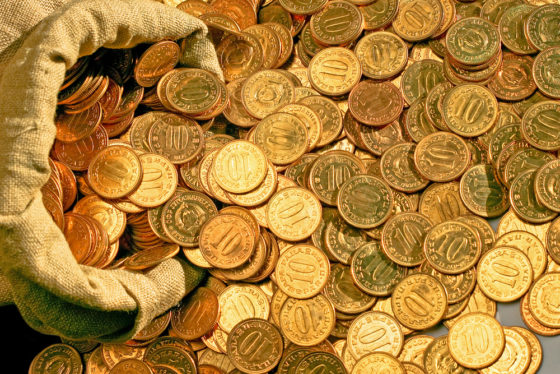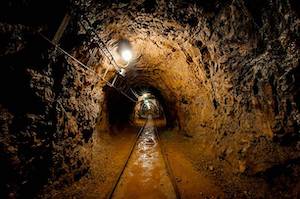
After several decades, China is again planning to use gold for international payments. The world’s biggest importer of bullion is preparing to launch an oil futures contract priced in yuan, and redeemable in gold.
This is big.
It’s a clear attempt to bypass the US as the holder of the world’s reserve currency.
‘China’s move is a beginning of the gold standard for trade in a new form,’ writes Nigam Arora, author of The Arora Report. ‘Gold is becoming less of a commodity and more of a currency as the contract is backed by nothing other than gold. If this move takes hold, gold prices could rise.’
This is something our global strategist Jim Rickards devoted a whole chapter to in his 2014 bestseller, The Death of Money.
These events are now happening. And the reasons to own gold are more pressing than ever.
China is the largest importer of oil in the world right now. Introducing a new ‘petro-yuan’ signifies a shift away from the established petrodollar.
It’s bad news for the US. But it could be great for gold holders.
A new rush is coming — don’t wait to get gold

Kettle Moraine, Ltd.
P.O. Box 579
Litchfield Park, AZ 85340
1-623-327-1778
Email: gold@kettlemorainepreciousmetals.com
Back in May, we caught up with Jim to talk about the Metal of Kings, and Australia’s long history with it.
The first gold discovery was at a waterhole near Bathurst in 1851.
Edward Hargreaves noticed a tiny fleck of gold in the water. From there, the rush was on.
Today, Australia accounts for around two-thirds of gold mine reserves. When it comes to gold in the ground — and getting it out — Australia is a global superstar.
But while you can almost ‘shake gold from the roots’ of the grass beneath your feet, the Reserve Bank of Australia has stockpiled a meagre bullion inventory.
Australia’s central bank doesn’t care much for owning gold…and individual Australians have followed its lead.
Many are sceptical about holding gold as a portion of their investment portfolios. They think that, if you do, you’re both a crank and doomsayer for owning the ‘barbarous relic’.
But Jim begs to differ…
In this Daily Reckoning Australia interview, he reveals why the disparity between Australian gold in the ground and its official reserves is actually a very worrying development for all Australians.
And that, if you don’t consider owning gold between now and 2020, you do so at your own peril.
Let’s begin…
DR: Overall, gold prices have dropped a good deal in the last five years. What do you say to any demoralised gold investors out there?
Jim: I’ve been in the markets for a long time. Not just the gold market, but the bond market, derivatives market, hedge funds, and around the stock exchange.
I have a lot of experience. And I’ve been privileged to meet some of the best traders in the world, people like John Meriwether, Bruce Kovner and others.
One thing they all have in common is that they have what I call ‘ice-water’ in their veins. What I mean by that, is they are not emotional about their trading and investment strategies.
Because I don’t talk about gold as a trading strategy – I talk about it as an investment strategy. It’s a way to preserve wealth, including under some very dire outcomes, which we may experience.
So when the price of gold goes up, I don’t get euphoric. When the price of gold goes down, I don’t get depressed.
As a matter of fact, I don’t even think of the price of gold. I think of gold as a constant.
If I see the dollar price of gold going up, that just tells me what’s really happening is that the US dollar is going down. And if the dollar price of gold goes down, that just tells me that the US dollar’s getting stronger.
So I think of gold as the constant. I think of the dollar as the fluctuating asset. As I said, I don’t get euphoric. I don’t get depressed. I just stay with it – for the long haul.
And I do that for several reasons.
Firstly, I think it’s good to have your gold now because when the panic comes, you may not be able to get it. I’ve had people say to me, ‘Hey, Jim, call me right before the market collapses, and I’ll sell my stocks and buy gold.’ And what I tell them is, first of all, I’m not going to know. I can see it coming, but I won’t know the exact hour or the exact day.
And secondly — and more importantly — even if I did know (which I don’t), it might be too late! You might not be able to get the gold. So the time to get some is now. Don’t focus on the day-to-day price fluctuations. That’s really noise.
Instead, think of gold as insurance on your house. Nobody wants their house to burn down, but heaven forbid, if it does, you’re glad you have the insurance. If you have insurance on your house, you don’t go out and call your insurance broker every day and say, ‘geez, is my insurance more expensive or less expensive?’
Jim: ‘Don’t wait to buy gold. When the time comes that you’ll need it, you won’t be able to get it.’

Jim Rickards
You don’t cancel your insurance policy for a week and say, ‘I’m going to buy it next week a little bit cheaper,’ because you’re exposed for that week. And that’s really the secret…
When you think of gold as insurance, I think that’s a good way to say, ‘you know what? I have it for a reason. I have it for protection. I’m in it for the long haul. I’m not going to get too euphoric or too depressed by the day-to-day noise.’
DR: Precious metals can shine in the aftermath of great crashes. What’s likely this time given that the rise in US stock markets has been so spectacular?
Jim: There are number of reasons to buy gold. The notion that there could be a market crash and the price of gold might go up, that’s one of them. But it’s not the only reason by any means. There are many factors that affect the price of gold.
There could be what’s called the ‘fear trade’. So everyone’s worried — stocks are going down, bond markets are illiquid, junk bonds are collapsing, emerging markets are collapsing, so I’m going to run into gold as a haven.
That’s a legitimate strategy for a portion of your portfolio. But there are other more subtle things that could cause the dollar price of gold to go up quite a bit.
One of them is inflation. Just because you have inflation doesn’t mean that you have a market crash. It could just be that the velocity of money is going up. Look at the late 1970s. By 1980, inflation was 14% in the States!
Yeah, there were some stock market volatility. We had a couple of recessions, although the market came back. But the price of gold was skyrocketing, not because of the stock market, but because of inflation. So inflation is a factor.
Another one is real interest rates. Everyone focuses on the interest rate that they hear about in the news. That’s the nominal interest rate. But the real interest rate is the nominal interest rate minus inflation or plus deflation, as the case may be.
Generally, negative real interest rates are very good for gold. So people say, ‘interest rates are really low right now.’ Well, nominally they are. But in real space, they’re not. Real interest rates are still high.
I remember when interest rates were 13%, and people would say, ‘gee, that’s astronomically high.’ But the real rate was negative because inflation was 15%.
If you have an interest rate of 13% and inflation of 15%, the real rate is actually -2. That’s actually a negative real rate. So those negative real rates are very good for gold.
Again, I’m referring to the late 1970s or early 1980s. And again, it doesn’t necessarily correspond to a stock market crash.
So yes, financial panics or financial collapses are one reason to have gold, but they’re not the only reason.
I don’t think gold investors should sit around waiting for that, although it’s good to be prepared if it happens. There are other threats out there, including inflation, the possibility of negative real rates that central banks are trying to engineer, and other factors.
Again, think of it as fire insurance on your house.
There might be 100 ways for the house to burn down, but the insurance policy pays off for every single one of them.
Again, nothing you want, but you’re glad to have the protection in case it happens.
DR: In August 2012 you said that America was the Saudi Arabia of gold reserves and China was a ‘gold pygmy’. China has since been stockpiling massive amounts of gold. Why has China been doing this?
Jim: I did say that at the time, and I was correct, that China’s gold position was small relative to its GDP. I didn’t mean they didn’t have any gold. I just meant if you look at the ratio of gold to GDP — that’s how big an economy is and how much gold is there to support it — they had a very low ratio.
But a lot has changed since 2012. China has been acquiring thousands of tons of gold.
To put it into perspective, there are only approximately 35,000 tons of official gold in the world. (When I say ‘official gold’, I mean gold owned by countries, central banks and sovereign wealth funds. I’m not talking about private gold and jewellery and what investors have, but just what governments have.) It’s about 35,000 tons.
China has acquired, by my estimate, something like 5,000 tons in the last six years. Now, that accumulation had started by 2012 and it’s accelerated greatly since then.
Bear in mind, China’s completely non-transparent about this. They do not accurately report their gold holdings. They do report them, but they hide a lot of the gold. The People’s Bank of China currently admits to having about 1,600 tons. But China actually has closer to 5,000 tons.
So where’s the rest of the gold?
They have another agency called the State Administration on Foreign Exchange (SAFE). So the gold in the SAFE…that’s non-transparent. It’s off the books. But they’ve got the gold.
How do we know? Well, we do have some data. We know that their mining output is about 450 tons a year. So if you take 450 tons a year, by six years, there’s over 2,500 tons right there.
We know the imports from Hong Kong, and Hong Kong actually does have accurate reporting, unlike the People’s Republic of China. We know from Hong Kong imports that they’ve taken in just under 1,000 tons a year, again, for six or seven years.
So you start to add all this up and you get to a number that is approaching kind of 9,000 or 10,000 tons.
What we don’t know exactly is how much of that gold went to private consumption in China (in other words, individual Chinese buying it) and how much went to the government. We’re not sure of that, but my estimate is 50:50. That’s the best estimate you can make in the absence of better information.
So, putting all that together, I would say that, today, China does have around 5,000 tons. And relative to its economy, they’re not a pygmy anymore. They’re on a par with the United States.
And by the way, that was the hidden decision behind the International Monetary Fund’s decision to include their currency — the Chinese Yuan — in the Special Drawing Rights (SDR) basket, which is IMF world money.
Of course, the Yuan is being more widely used in trade and in other ways, but what really happened is that China joined the ‘gold club’.
Think of it as a poker game.
You have four players sitting around the table. If one player has all the chips, it’s not a very interesting game. In fact, there’s no game at all.
So you want everyone to have a pile of chips, then you can start playing poker.
Gold are your poker chips in the game of international monetary rearrangement, international monetary system reform, and China didn’t have a very big pile of chips.
But now they do.
Written by James Woodburn and published by the Daily Reckoning ~ September 28, 2017.
FAIR USE NOTICE: This site contains copyrighted material the use of which has not always been specifically authorized by the copyright owner. We are making such material available in our efforts to advance understanding of environmental, political, human rights, economic, democracy, scientific, and social justice issues, etc. We believe this constitutes a ‘fair use’ of any such copyrighted material as provided for in section 107 of the US Copyright Law. In accordance with Title 17 U. S. C. Section 107, the material on this site is distributed without profit to those who have expressed a prior interest in receiving the included information for research and educational purposes. For more information go to: http://www.law.cornell.edu/uscode/17/107.shtml








